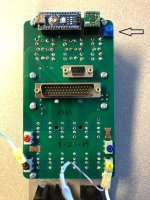Twinotter79
I'm New Here
Hello everyone,
This is my first post on VAF. I am just about to finish building an RV-12iS. The airplane has not flown, and I'm having an issue with the Stabilator trim not working. I have the Garmin G3X IFR package with Autopilot.
I have completed Safety Directive SD-0001 and have the new servo installed. The trim worked fine about a week ago, but now I can't get it to run in either direction from the trim switches on the sticks. Everything else on the electrical system seems to work fine.
Here are the actions I've taken to troubleshoot the problem:
1) The trim fuse is intact
2) The ships battery voltage is good at 13.5 volts
3) I've disconnected the D-sub connection at the servo, and successfully run the servo off a 12V external battery.
4) I've also run the servo successfully from the WH-P-30 at the D-sub connector at the AV-60000 power module with the external battery.
5) I am getting power to the control sticks, however the trim switches won't work.
6) I've adjusted the trim speed Pot to the full counter-clockwise position.
7) I've checked the tension on the AST actuator bolts and they can be turned by hand.
Reading some of the previous posts these trim issues seem to be an ongoing problem.
What am I missing here?
Thanks, John
This is my first post on VAF. I am just about to finish building an RV-12iS. The airplane has not flown, and I'm having an issue with the Stabilator trim not working. I have the Garmin G3X IFR package with Autopilot.
I have completed Safety Directive SD-0001 and have the new servo installed. The trim worked fine about a week ago, but now I can't get it to run in either direction from the trim switches on the sticks. Everything else on the electrical system seems to work fine.
Here are the actions I've taken to troubleshoot the problem:
1) The trim fuse is intact
2) The ships battery voltage is good at 13.5 volts
3) I've disconnected the D-sub connection at the servo, and successfully run the servo off a 12V external battery.
4) I've also run the servo successfully from the WH-P-30 at the D-sub connector at the AV-60000 power module with the external battery.
5) I am getting power to the control sticks, however the trim switches won't work.
6) I've adjusted the trim speed Pot to the full counter-clockwise position.
7) I've checked the tension on the AST actuator bolts and they can be turned by hand.
Reading some of the previous posts these trim issues seem to be an ongoing problem.
What am I missing here?
Thanks, John





